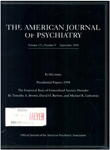HIV seroprevalence among homeless patients admitted to a psychiatric inpatient unit
Abstract
OBJECTIVE: This study was conducted to determine the seroprevalence of HIV-1 antibodies among hospitalized homeless mentally ill patients. METHOD: From December 1989 through May 1991 the authors collected discard blood samples from patients consecutively admitted to a psychiatric unit designated for the care of severely mentally ill persons removed from the streets of New York City. The blood samples were tested for HIV-1 antibodies, and the results were analyzed for associations with age, gender, ethnicity, male homosexual activity, and use of injected drugs. RESULTS: The HIV seroprevalence was 6.4% (13 of 203 samples). Patients between ages 18 and 39 accounted for 51.2% of the admissions and 84.6% of the 13 positive results, a seroprevalence of 10.6% for this subsample. Patients under age 40 were more than six times as likely to test positive for HIV antibodies as those 40 or over. Ethnicity did not predict seropositivity. Women were as likely as men to be infected. Although clinicians had noted high-risk behavior on the charts for only three (23.1%) of the 13 positive cases, a recorded history of use of injected drugs was associated with a 6.5-fold greater risk of HIV seropositivity. CONCLUSIONS: One in every 16 patients admitted to the special unit was HIV positive. Age under 40 and use of injected drugs were strongly associated with seropositivity. Because information on high-risk behavior was infrequent, the reasons for younger patients' greater risk are unclear. The homeless mentally ill require outreach efforts to reduce the risk of acquiring or transmitting HIV.
Access content
To read the fulltext, please use one of the options below to sign in or purchase access.- Personal login
- Institutional Login
- Sign in via OpenAthens
- Register for access
-
Please login/register if you wish to pair your device and check access availability.
Not a subscriber?
PsychiatryOnline subscription options offer access to the DSM-5 library, books, journals, CME, and patient resources. This all-in-one virtual library provides psychiatrists and mental health professionals with key resources for diagnosis, treatment, research, and professional development.
Need more help? PsychiatryOnline Customer Service may be reached by emailing [email protected] or by calling 800-368-5777 (in the U.S.) or 703-907-7322 (outside the U.S.).



